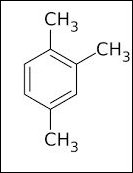
The chemical structure of 1,2,4 trimethylbenzene, of which 132,000 pounds were released into Virginia’s air and waterways in 2017. Are we safe? Should you be worried? Should government spend billions to “do” something?
The West Point paper mill, one of Virginia’s 10 largest emitters of toxic materials in 2017, emitted 7.6% fewer toxic materials in 2017 compared to the year before, reports the Daily Press today. All told, the paper mill released 852,914 pounds — mostly menthol, ammonia, and hydrochloric acid — into the air and water. That news got me to thinking…
There are a couple of obvious story lines that could be extracted from the data, which comes from the release of 2017 numbers from the Toxic Release Inventory (TRI). One, which the Daily Press adopts, is that West Point, like other major manufacturers, has done an excellent job over the years in grinding out steady reductions in the volume of toxic chemicals it releases into the environment.
The other story line is the degree to which Virginians are absolutely insensate to the massive volume of chemicals pumped into the air and water. The TRI lists 138 toxic chemicals from 1,2,4-Trimethylbenzene to zinc compounds — totaling 34.5 million pounds in all. These chemicals vary widely in their emission volumes, their toxicity, and the speed with which they break down or are otherwise rendered harmless.
But one thing these compounds have in common is that no one is losing sleep over them.
The citizens of West Point aren’t falling into fits of anxiety over being poisoned or afflicted with cancer from the 853,000 pounds of toxic emissions from their local paper plant. Politically speaking, with the highly visible exception of the furor over trace quantities of slow-leaking heavy metals from coal ash pits which triggered a $1 billion+ cleanup plan, toxic chemicals are a non-issue in Virginia.
Environmentalists succeeded in generating widespread alarm over coal ash disposal. But the release of 132,000 pounds of, say, 1,2,4-Trimethylbenzene or 331,400 pounds of acetalhyde doesn’t create a ripple.
My point here is not to criticize the remedies enacted to prevent the leakage of heavy metals from coal ash pits into Virginia waterways. It’s that politicians make billion-dollar environmental decisions with absolutely no concept of relative risk. What level of risk would be posed by the slow leakage of heavy metals from coal ponds, measured in a few parts per million, compared to the 2017 release of 311,000 pounds of lead compounds, 1.4 million pounds of zinc compounds, and 1,500 pounds of mercury compounds directly into the air and water?
I have no idea what the relative risks are. The citizenry has no idea. The media have no idea. The politicians have no idea. And I doubt even the environmentalists have any idea.
Here’s how it works in Virginia: Environmentalists fixate on an issue and gin up alarm, the media uncritically passes on that fixation to the public and the political class, and then the political class moves to “fix” the perceived problem with little regard to cost. Is this a rational way to allocate scarce resources? Do we have any assurance that society is getting the most “bang for the buck” in addressing environmental concerns? The answer in both cases is a resounding, “No.”
As an aside… For what it’s worth the 34.5 million pounds of toxic and potentially toxic chemicals emitted into Virginia skies and water in 2017 compares to 66.7 million pounds in 2007 — a 48% reduction over the past decade. Are you feeling safer from the threat of environmental harm than you did 10 years ago? No, I didn’t think so.


